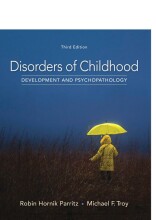Summary: Disorders Of Childhood: Development And Psychopathology | 9781337098113 | Robin Hornik Parritz, et al
- This + 400k other summaries
- A unique study and practice tool
- Never study anything twice again
- Get the grades you hope for
- 100% sure, 100% understanding
Read the summary and the most important questions on Disorders of Childhood: Development and Psychopathology | 9781337098113 | Robin Hornik Parritz; Michael F. Troy
-
4 Externalizing Disorders
-
4.2 ODD, CD & ASPD
This is a preview. There are 29 more flashcards available for chapter 4.2
Show more cards here -
What are typical aspects of ODD, CD & ASPD?
- Involve problems in the self-control of emotions & behaviors
- Violate the rights of others
- Bring the individual into significant conflict with societal norms or authority figures
-
What are the 2 groups of people that exhibit anti-social behavior?
- The Adolescence Limited (AL) group = those who only show antisocial behavior during the “normative peak”
- The Life-Course Persistent (LCP) group = those who show antisocial behavior during their entire life
-
What is typical for the Life-Course Persistant group that exhibits anti-social behavior?
They show antisocial behavior during their entire lifetime -
What type of antisocial behavior is both destructive and covert?
Property violations, like vandalism and theft -
What type of antisocial behavior is both destructive and overt?
Physical agression, like bullying, fighting and assault -
What type of antisocial behavior is both nondestructive and covert?
Status violations, like rule breaking, truancy and substance use -
What type of antisocial behavior is both nondestructive and overt?
Oppositional behavior, like temper tantrums, angry, touchy and argumentative -
What does the developmental course of antisocial behavior look like?
Cascade of behaviors: one adding onto the other -
What are two aspects of the developmental course of antisocial disorders?
- Diversification: addition of new behavior problems
- Aggression
- Diversification: addition of new behavior problems
-
What are the three pathways in the developmental course of antisocial disorders?
- Overt pathway
- Covert pathway
- Authority conflict pathway
- Overt pathway
- Higher grades + faster learning
- Never study anything twice
- 100% sure, 100% understanding
Topics related to Summary: Disorders Of Childhood: Development And Psychopathology
-
Externalizing Disorders - ODD, CD & ASPD - Oppositional Defiant Disorder
-
Externalizing Disorders - ODD, CD & ASPD - Conduct Disorder
-
Externalizing Disorders - ODD, CD & ASPD - Antisocial Personality Disorder
-
Externalizing Disorders - Substance Use & Gambling Disorders
-
Internalizing Disorders - Anxiety, Trauma & PTSD - Anxiety
-
Internalizing Disorders - Anxiety, Trauma & PTSD - Post Traumatic Stress Disorders
-
Internalizing Disorders - Depression
-
Eating Disorders - Eating Disorders & Depression
































